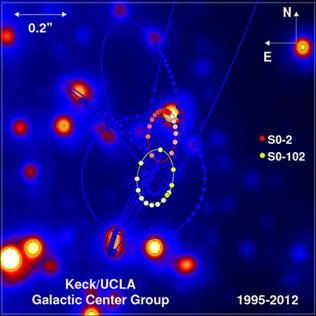 |
| Never forget to be awestruck by what we can do |
First, the very concept of a black hole makes it impossible to 'see'. A black hole emits no energy at any wavelength (well, except for something called 'Hawking Radiation' that we can skip over for now), so none of our observational tools can measure it directly. And second, the center of the galaxy is a very dense, busy, messy place full of huge clouds of interstellar dust and gas - essentially the same stuff planet earth is made of. These clouds effectively block a broad portion of the EM spectrum, including visible light, which prevents us from seeing much of anything going on in the entire central region.
But all is not lost. We have radio telescopes, which capture the longer wavelength energy that passes easily through the obscuring interstellar medium, and we have IR - infrared radiation that is generated by heat, that can be detected behind and through the clouds of dust and gas. And what's that we see? Stars orbiting the black hole in small, tight orbits. The bell cow was a star they called S-2, and by measuring the mass of that star and analyzing its orbital dynamics, scientists could reach some conclusions about the structure of the black hole we call Sgr A*. And the numbers are beyond mind boggling. With the mass of nearly four and a half MILLION times that of our sun, it's only 13 million miles across. The density of an object like that is unimaginable. And sitting way out here, we figured all that out.
Is this a new breakthrough? Actually, far from it. Sgr A* was first discovered in 1974, and named ten years later. You'll notice on the attached image that we've been tracking the orbits of surrounding objects for more than 20 years. Also note that the key objects, S-2 and S-102 together encompass a tiny bit of sky less than half an arc-second across. This is precision astronomy of the first order. And here we are, a species of intelligent primates evolved all on our own on a dusty little rock in a distant rural corner of our galaxy, looking at the enormity and complexity of our universe, and coming to understand it. If I take any comfort in my own mortality, it is rooted in that accumulated knowledge, and in our drive and cleverness that allows us to keep accumulating more.
...
No comments:
Post a Comment